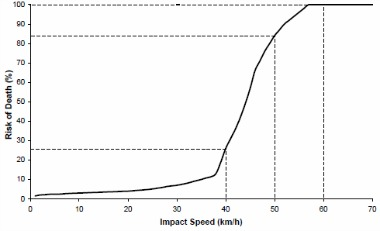The need for less speed
2 Sep 2016
One of the great successes in reducing the road toll since the 1970s has been reducing vehicle speeds.
The introduction of the 50 km/h default urban speed limit in Victoria resulted in in a reduction in casualty crashes of around 12%, and a 25-46% reduction in pedestrian fatal and serious injury crashes on applicable roads.
Still, our roads could be so much safer, especially for pedestrians.
VicRoads recently released new Draft Speed Zoning Guidelines, for comment by road managers. They say “On average, eight out of ten pedestrians die if hit by a car travelling at 50 km/h, while only one out of ten dies if the car is travelling at 30 km/h.”
A comprehensive study of the introduction of 20 mph (32km/h) zones in London found a 32% reduction in pedestrian casualties (fatalities and injuries). The benefits for child pedestrians were even more significant – a 47% reduction for those aged 0-5 and a 51% reduction for 6-11 year olds. There was a decrease of 42% for traffic casualties overall.
Despite this evidence, the revised Victorian Guidelines do not change the existing Guidelines - they don’t even give councils the option of applying 30 km/h speed limits. Not even in town centres, as they are in other parts of Australia and New Zealand. Apart from in shared zones, the lowest allowable speed limit under the Guidelines is 40 km/h. But a pedestrian struck at 40 km/h is around 2.5 times as likely to die as one hit at 30 km/h.
Towards Zero 2016//2020 Victoria’s Road Safety Strategy and Action Plan notes that with the population growing and ageing “…trauma levels could rise in the next five years unless we take bolder approaches to road safety.” Indeed, the road toll is significantly higher so far this year than it was last year.
Rather than taking the bolder approach required, the Draft Speed Zoning Guidelines appear to reflect a ‘business as usual’ approach. In fact, by preventing the application of 30 km/h speed limits, they may stop us from getting closer to the Towards Zero goal.
Read Victoria Walks’ comments on the Draft Speed Zoning Guidelines here.